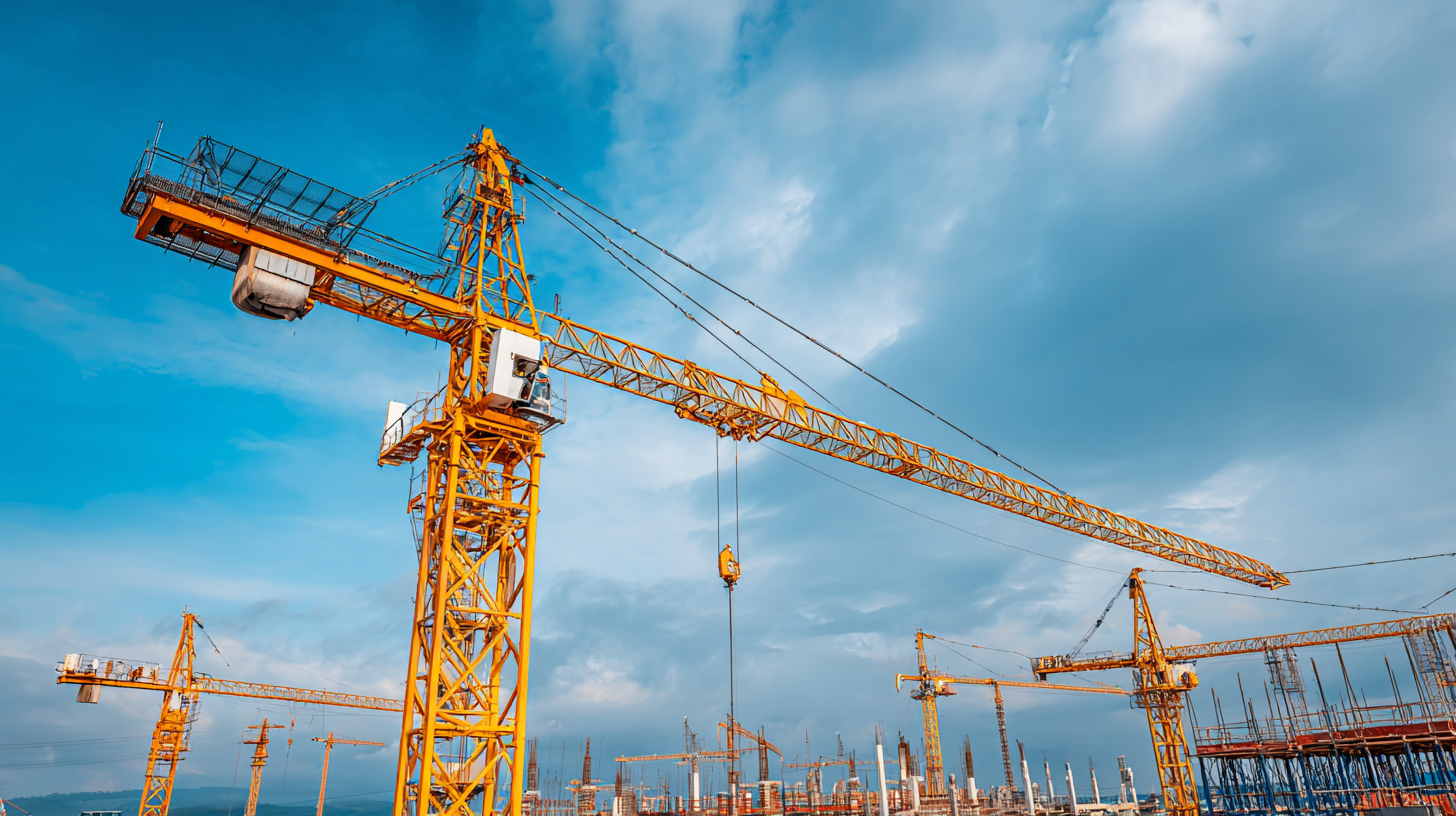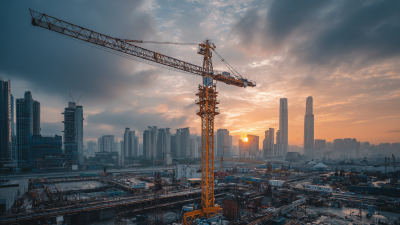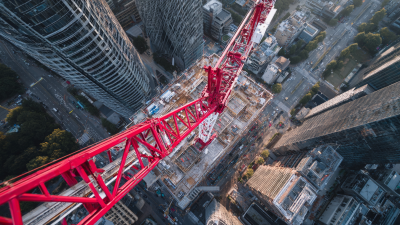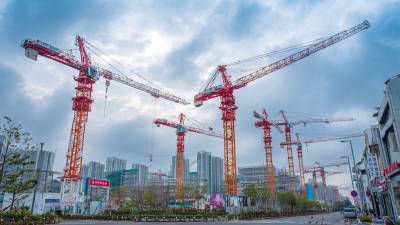In the rapidly evolving landscape of modern construction, the integration of innovative machinery has become paramount for enhancing efficiency and productivity. Among these, the Tower Crane stands out as a pivotal piece of equipment, facilitating the lifting of heavy materials and enabling complex structural formations. According to the International Construction Equipment Market report, the demand for Tower Cranes has surged by over 20% in recent years, reflecting their essential role in high-rise construction projects and large-scale developments.

The capability of Tower Cranes to operate at varying heights and adapt to diverse job site conditions significantly contributes to project timelines and cost-effectiveness. Furthermore, advancements in technology have led to the development of smart Tower Cranes equipped with sensors and telematics, optimizing operations and minimizing downtime. As construction projects increasingly prioritize efficiency and sustainability, the Tower Crane emerges not only as a tool of convenience but as a cornerstone for modern construction practices.
Tower cranes have become a vital asset in modern construction practices, significantly enhancing efficiency, particularly in large-scale projects. Their height and capacity allow for the lifting of heavy materials to great heights, which drastically reduces the time required for the transportation of materials across the construction site. This capability is essential in bustling environments where multiple tasks aren't just happening simultaneously but also require precision and reliability. The projected growth of the Tower Crane Rental Market to USD 22.1 billion by 2030 underscores the increasing reliance on these machines to meet the demands of expansive projects and infrastructure development.

Tip: When renting a tower crane, always evaluate the specific requirements of your project, such as height limitations and load capacities. This ensures you select the right crane tailored to your needs, ultimately enhancing your project's efficiency.
Additionally, as the UAE tower crane rental industry continues to thrive amidst a construction boom and various mega projects, businesses need to stay informed about market trends. Understanding the dynamics of this market can help stakeholders make informed decisions regarding equipment rental and investment.
Tip: Keep an eye on emerging technologies in tower cranes, such as automation and telematics, which can further streamline operations and improve safety on the construction site. Adopting these innovations can lead to more efficient project delivery.
The utilization of tower cranes in modern construction practices is essential for enhancing the cost-effectiveness of building projects. As the Tower Crane Rental Market is projected to reach USD 22.1 billion by 2030, it indicates a significant shift towards leveraging these machines for efficiency and safety on-site. Tower cranes offer impressive lifting capabilities, allowing for the rapid movement of materials at height, which reduces the time and labor costs associated with construction tasks.
In regions like North America, where the Crane Rental Market is expected to grow to USD 14.43 billion by 2033, industries are recognizing the importance of efficient construction logistics. The deployment of advanced logistics systems and heavy machinery enhances site operations, making tower cranes an integral part of modern building strategies. Their ability to optimize workflow not only speeds up construction timelines but also minimizes waste, ensuring that projects remain within budget while meeting the growing demand for sustainable building practices.
Tower cranes play a pivotal role in enhancing safety on modern construction sites. According to a report by the International Society for Automation, the use of tower cranes can reduce workplace accidents by up to 30%. This significant improvement can be attributed to their ability to lift heavy materials to great heights with precision, minimizing the need for manual handling, which is often a source of injuries. Moreover, tower cranes are equipped with advanced technology such as anti-collision systems and load monitoring sensors, further improving safety standards on-site.
Additionally, a study published by the Occupational Safety and Health Administration (OSHA) highlights that construction sites that employ tower cranes experience fewer incidents related to falling objects, one of the leading causes of construction-related injuries. The strategic placement of tower cranes allows for effective material flow and efficient site management, reducing the chaos that often leads to accidents. By minimizing manual lifting and streamlining operations, tower cranes not only boost productivity but also create a safer working environment for all personnel involved in construction projects.
| Benefit | Description | Impact on Safety | Percentage Reduction in Accidents |
|---|---|---|---|
| Enhanced Visibility | Tower cranes provide a clear line of sight for operators, reducing blind spots. | Allows for better monitoring of the worksite and surrounding areas. | 30% |
| Increased Lifting Capacity | Tower cranes can lift heavy materials to significant heights. | Reduces the need for multiple lifts, minimizing the risk of accidents. | 25% |
| Stability in High Winds | Designed to provide stability and safety even in adverse weather conditions. | Decreases the risk of collapses and falling loads. | 20% |
| Reduced Risk of Human Error | Automation features minimize the reliance on manual lifting. | Lowers the chances of accidents caused by operator mistakes. | 35% |
| Improved Coordination | Integrates with site logistics for better planning and execution. | Enhances teamwork and reduces conflicts in material handling. | 15% |
In modern construction practices, tower cranes have emerged as essential tools that enhance operational agility, leading to faster project timelines and more efficient delivery. According to a report by the Building Research Establishment (BRE), the use of tower cranes can reduce construction time by up to 20% compared to traditional methods. This time efficiency is particularly crucial in urban projects where space and time are often limited, enabling contractors to meet tight deadlines and keep projects within budget.
Moreover, the versatility of tower cranes allows for a wide range of lifting capacities and heights, making them suitable for various construction tasks. As highlighted in the International Journal of Construction Management, projects utilizing tower cranes benefit from increased productivity, with average productivity rates improving by 30% when tower cranes are employed. This boost in operational efficiency not only accelerates project completion but also enhances safety on-site, as tower cranes provide better visibility and control during material handling activities. By leveraging the advantages of tower cranes, construction firms can deliver high-quality projects more swiftly, positioning themselves favorably in a competitive market.
Tower cranes play a crucial role in promoting sustainability within modern construction practices. By enabling the efficient lifting and transportation of heavy materials, they reduce the need for multiple smaller cranes and construction vehicles, thereby minimizing fuel consumption and lowering carbon emissions. This efficiency not only streamlines the construction process but also minimizes the environmental footprint of a project, aligning with eco-friendly building practices.

Moreover, tower cranes can be strategically placed to optimize space and resources on construction sites. Their ability to maneuver materials to significant heights and across large areas allows for efficient use of lighter materials, such as sustainable composite materials and recycled elements. This access reduces waste, as fewer resources are needed to achieve the same structural integrity. In turn, incorporating tower cranes into construction projects enhances the overall sustainability efforts of the industry, making them indispensable in the shift toward greener building practices.








